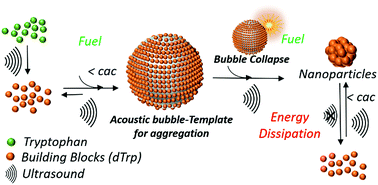当前位置:
X-MOL 学术
›
Nanoscale Horiz.
›
论文详情
Our official English website, www.x-mol.net, welcomes your
feedback! (Note: you will need to create a separate account there.)
Sound-driven dissipative self-assembly of aromatic biomolecules into functional nanoparticles.
Nanoscale Horizons ( IF 8.0 ) Pub Date : 2020-03-02 , DOI: 10.1039/c9nh00611g Sukhvir Kaur Bhangu 1 , Gianfranco Bocchinfuso 2 , Muthupandian Ashokkumar 1 , Francesca Cavalieri 3
Nanoscale Horizons ( IF 8.0 ) Pub Date : 2020-03-02 , DOI: 10.1039/c9nh00611g Sukhvir Kaur Bhangu 1 , Gianfranco Bocchinfuso 2 , Muthupandian Ashokkumar 1 , Francesca Cavalieri 3
Affiliation

|
Dissipative self-assembly processes were recently exploited to assemble synthetic materials into supramolecular structures. In most cases, chemical fuel or light driven self-assembly of synthetic molecules was reported. Herein, experimental and computational approaches were used to unveil the role of acoustic cavitation in the formation of supramolecular nanoaggregates by dissipative self-assembly. Acoustic cavitation bubbles were employed as an energy source and a transient interface to fuel and refuel the dissipative self-assembly of simple aromatic biomolecules into uniform nanoparticles. Molecular dynamics simulations were applied to predict the formation of metastable aggregates and the dynamic exchange of the interacting molecules in the nanoaggregates. The intracellular trafficking and dissipative dissolution of the nanoparticles were tracked by microscopy imaging.
中文翻译:

声音驱动的芳香生物分子的耗散自组装成功能性纳米粒子。
最近利用耗散自组装过程将合成材料组装成超分子结构。在大多数情况下,据报道化学燃料或光驱动合成分子的自组装。本文中,实验和计算方法被用来揭示声空化在通过耗散自组装形成超分子纳米聚集体中的作用。声空化气泡被用作能源和瞬态界面,为简单的芳香生物分子的耗散自组装加燃料并为其加油,形成均匀的纳米颗粒。分子动力学模拟用于预测亚稳聚集体的形成以及纳米聚集体中相互作用分子的动态交换。
更新日期:2020-03-02
中文翻译:

声音驱动的芳香生物分子的耗散自组装成功能性纳米粒子。
最近利用耗散自组装过程将合成材料组装成超分子结构。在大多数情况下,据报道化学燃料或光驱动合成分子的自组装。本文中,实验和计算方法被用来揭示声空化在通过耗散自组装形成超分子纳米聚集体中的作用。声空化气泡被用作能源和瞬态界面,为简单的芳香生物分子的耗散自组装加燃料并为其加油,形成均匀的纳米颗粒。分子动力学模拟用于预测亚稳聚集体的形成以及纳米聚集体中相互作用分子的动态交换。











































 京公网安备 11010802027423号
京公网安备 11010802027423号